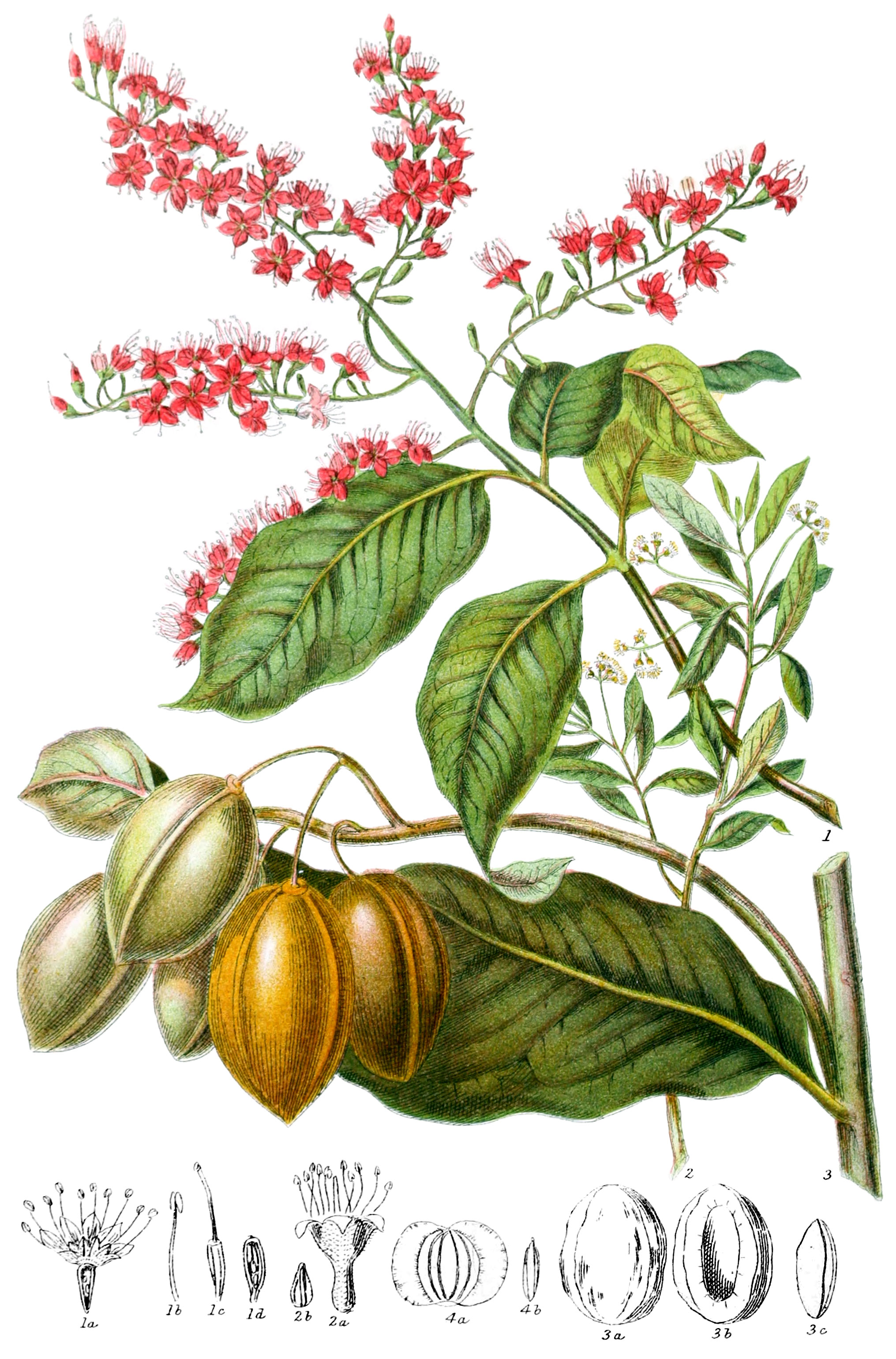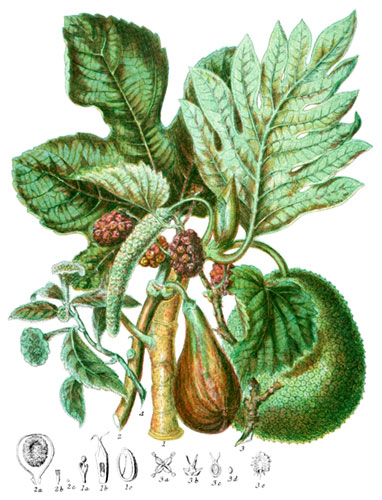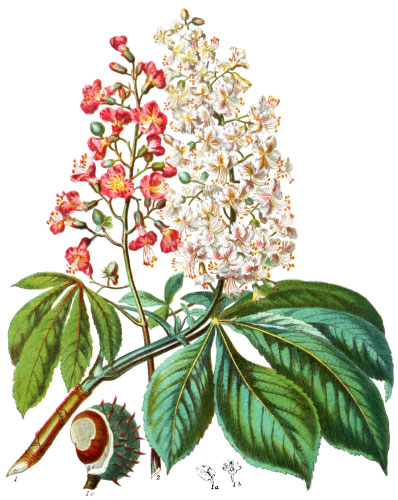Key characteristics
Trees and shrubs; the leaves are alternate or opposite, without stipules, entire at the edge; the leafstalk has sometimes two glands at the end. The spikes of flowers grow at the ends of the branches, or proceed from the base of the leafstalks. The calyx is adherent in the lower part, with a four or five lobed limb, which falls off. The petals arise from the orifice of the calyx, and are alternate with its lobes, often wanting, as in Terminalia (2). The stamens grow from the upper part of the calyx, and are twice as many as its segments; very rarely equal to them in number. The filaments are distinct, awl-shaped. The anthers are two-celled, bursting lengthwise, or by recurved valves, as in Gyrocarpus. The ovary is one-celled, with from two to four ovules suspended by cords from the top of the cavity; the style is single, the stigma simple. The fruit is a drupe, a berry, or a nut, one-celled; usually one-seeded, closed, often winged. The seed is pendulous, without albumen.
These plants have considerable affinity with the Myrtle tribe, especially with the Pomegranate.
Astringent properties prevail in the bark and fruit.
Select plants in this order
Not all plants listed are illustrated and not all plants illustrated are listed.
- Combretum (or Poivrea, as it has lately been called) is a genus o elegant plants, differeing entirely from that described by Pliny under the same name.
- C. purpureum (1) is a remarkably graceful species, flowering abundantly in a conservatory; the small bracts soon fall off after the flower expands.
- C. grandiflorum of Sierra Leone bears a shorts spike of drooping flowers with scarlet petals and a long green clayx; the bracts are larger than those of other species and stand erect.
- C. micropetalum, with yellow flowers, grows in the primæval forests of Minas Geraes and other provinces of Brazil.
- A gum resembling gum arabic is yielded from the bark of C. alternifolium; this appears to be a solitary instance of useful product in the genus.
- Terminalia the Myrobalan includes several important and valuable species existing in the tropics of both hemispheres in low, damp localities, rarely in dry situations exposed to wind; they afford timber, bark for tanning, food, and medicine.
- T. Catappa (3) is a fine tree with broad leaves; the kernels of the fruit are eaten by the natives, and are said to have the flavour of almonds.
- T. fagifolia is a native of Brazil, growing to the height of thirty feet; the stem has an extremely thick bark, the leaves are in clusters at the ends of the branches, and are densely hairy. The fruit (4) is destitute of a fleshy exterior, and is covered only with a fibrous fungus-like substance; the margin of the wings is clothed with a silky down.
- The milky juice of T. Benzoin is so fragrant when dried as to serve as incense in the churches of Mauritius.
- T. argentea yields a powerful resin.
- T. Chebula has glands on the leafstalk; the astringent fruit is very valuable in dyeing; combined with alum, it produces yellow, or mixed with the ferrugineous ud of the country, it forms a good black.
- Several species are employed medicinally; the root of T. latifolia is esteemed in Jamaica; the bark of T. alata is a remedy in fever; the astringent fruit of T. belerica is used as a tonic; from the bark exudes a gum which dissolves in water and consumes in flame.
- The kernels of T. citrina are among the native medicines of the Hindoos.
- Some species of Terminalia as well as of Conocarpus and Pentaptera are of considerable dimensions, and yield excellent timber.
- The bark of Conocarpus is of use in tanning, in Rio Janeiro.
- Chuncoa has a leathery fruit, with five membranous wings of unequal size, the two larger semi-orbicular and downy.
- Laguncularia is a shrub bearing spikes of flowers, the calyx of which is covered with a white down; it is frequent in the marshes near the coast of Rio Janeiro; the fruit was found ripe in the month of April by Von Martius.
- The fruit of Bucida Buceras is the shape of the horn of an ox; the tree abounds in the swaps of Jamaica, and affords timber and bark for tanning.
- Alangium and a few other genera differ in a few points from the regular type of this Order, sometimes ten in number, and the seeds containing albumen; the roots of Alangium are aromatic, and the fruit eatable though insipid.
- Nyssa capitata bears a small fruit the size of an olive; the fibres of the wood are much interwoven, which renders it difficult to split.
Locations
The chief trees and shrubs of this Tribe belong exclusively to the Tropical regions of Asia, Africa, and America, and do not extend beyond them. Nyssa belongs to the United States of America.
Legend
- Combretum purpureum. Madagascar.
- Flower.
- Stamen.
- Pistil and Ovary.
- Section of Ovary.
- Terminalia Australis. Brazil.
- Flower, magnified.
- Fruit, magnified.
- Terminalia Catappa. East Indies.
- Stone of Fruit.
- A Valve removed.
- Kernel.
-
- Terminalia fagifolia, Winged Fruit. Brazil.
- Seed.
Explore more
Posters
Decorate your walls with colorful detailed posters based on Elizabeth Twining’s beautiful two-volume set from 1868.
Puzzles
Challenge yourself or someone else to assemble a puzzle of all 160 botanical illustrations.





